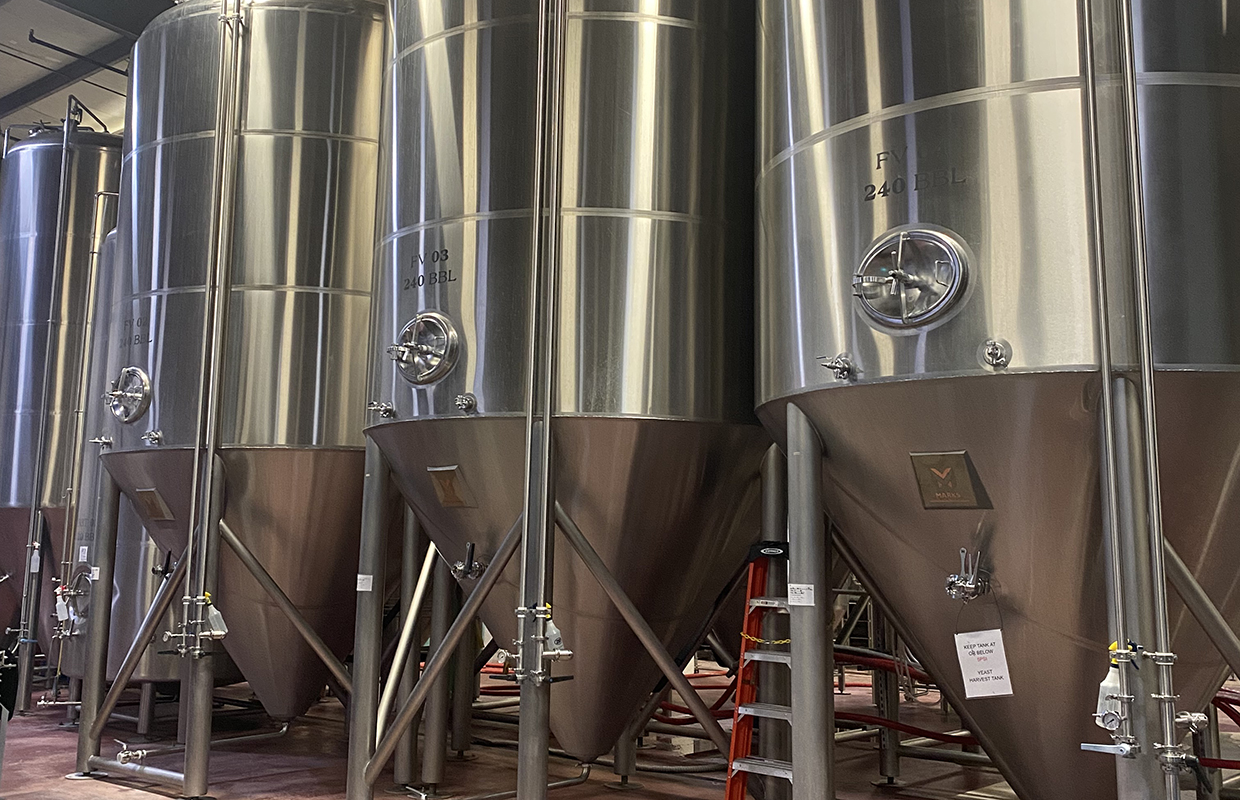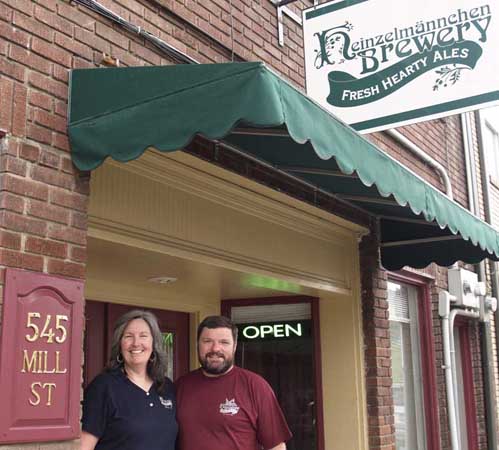
Great beers can be made with either type of yeast, be it starting as a dry pitch that is rehydrated or pitching liquid yeast and propagating up.
It all comes down to personal preference, application, and limiting factors of what you can get your hands on and Brewer was able to get insights thanks to GoodLife‘s Andrew Caramagno and Foundation‘s Joel Mahaffey on a vast array of thoughts.
At GoodLife, Caramagno said they exclusively use liquid yeast for all of its house strains — ale, lager, and hazy. One of the biggest contributing factors to the Bend, Oregon brewery’s heavy use of liquid yeast props is its proximity to both Wyeast and Imperial Organic yeast companies.
“With both sources of fresh yeast pitches being less than 120 miles away, we have the benefit of extremely fast shipping which leads to healthier yeast in our cooler right when we need it,” Caramagno said. “We also find that use of fresh liquid yeast provides us with a direct pitch to our propagation tanks with less lag, greater viability, and vitality, as well as quicker fermentation times.
“Quickly confirming cell count, viability and vitality is also a huge advantage of liquid yeast over dry. With dry, the same can be done, but one would have to correctly rehydrate before counting cells to confirm the correct pitch for their beers.”
For Caramagno, what makes liquid yeast great for GoodLife, can also give rise to some potential negatives.
“Since these pitchable quantities are fresh from the manufacturer, they must be shipped and received within a very short period to keep from spoiling as they are much more perishable compared to dry yeasts,” he said. “For us, this isn’t so much of a problem, though we do occasionally lose a prop due to mishaps in the shipping pipeline.”
GoodLife does not have designated yeast brinks, instead, Caramagno said they utilize 7- and 15-barrel fermenters for all yeast propagation.
“We rely on highly aerated, low BU wort as a base, healthy yeast pitch, and quick propagation to full tank fill times to keep everything running smoothly,” he said. “We picked our prop fermentation temperatures based on the higher end of the recommended range from the manufacturer, which is the same as our diacetyl rest temperature.
“For our props at these temperatures, we observe limited lag phase and fast cell growth to build up biomass in a short period.”
Located in Portland, Maine, Mahaffey said that the brewery has gone through a variety of changes in yeast usage over the years with the pandemic altering thought processes drastically.
When they first began, they harvested into the half-barrel brinks.
“They take up a lot of room [in your cooler], and they have a shelf life,” he said. “From a quality perspective, it worked fine. We used yeast that was a pretty hard flocculating yeast. And so it was notoriously difficult for us to get accurate cell counts out of the brinks. And we wanted to count every brink because we pitched by weight to try to achieve a target cell density in the new brew.
“The first brink you harvest is going to be a different density than the last brink that you harvest. So it was a lot of work.”
Foundation also ran micro on all the brinks to make sure that they weren’t pitching something dirty into a new brew and propagating that along.
”It worked, but there was a lot of work involved,” Mahaffey said. ”Sometimes if we didn’t have a really thick harvest and we were brewing 60 barrels, we’d end up pitching like 6-8 brinks of yeast into that batch. It was a lot of work on the part of a production crew.”
But when the pandemic hit and staffing were cut down to limit contact among employees, one of the things that were immediately on the table was, how to make it easier and require less manpower.
“So we ended up switching to dry yeast,” Mahaffey said. “That was super easy and we didn’t even harvest it.”
He said they were able to analyze all the labor savings by cutting out harvesting and washing the brinks in between every harvest, pitching the brinks, and all the micro and cell counting checks.
“It was well worth switching over to dry yeast and just calling it one and done,” he said. “We had a pretty standard pitch rate of bricks of dry yeast. And it was really easy.”
A diastaticus problem was eventually traced back to the dry yeast source, so they switched back to liquid yeast. By then, they had gotten used to not having to deal with the brink harvesting and all the quality checks on it anymore so they decided to give cone-to-cone pitching a shot and it has become the standard now for the brewery.
“We fill the cone of the fermenter to a particular level depending on what kind of beer and how much volume is going into the tank,” Mahaffey said. ”It’s easy, and it works. We do not have problems with overly aggressive fermentation.”
Because they’re not doing micro on yeast harvests the way that they used to, Foundation will keep generations to typically no more than five generations. Any Sours made use new pitches to avoid any contamination as well.
”We hook up a clean, sanitized hose from a tank that is either crashed or ready to be dry-hopped, and put the yeast over to another tank,” Mahaffey said. ”Sometimes we’ll do that a couple of days before we’re even going to knockout into it, and just let that yeast hang out in the clean tank, waiting to receive the wort.”
Before opening the brewery, Mahaffey admitted it was definitely frowned upon as a very inaccurate way of pitching yeast.
“They’re absolutely correct that I have no idea what my cell density is, how many million cells I’m pitching per mL,” he said. “But if this were going into brinks, it would be about this many brinks set as a standard harvest rate. So let’s put about this much in the tank. And let’s see how it goes. We erred on the side of too much yeast, rather than not enough yeast at the beginning and just kind of pulled it back from there.”
Recently Foundation has begun buying liquid yeast props and then divert some wort off of a brew on a Monday into a different tank and adding a very small amount of yeast and allowing that to prop up Monday night.
“Then we’ll do a different brew on Tuesday,” Mahaffey said. “There are some good cost savings that go along with that, especially for things that we may not be able to go five generations on.”
For Caramagno, what makes liquid yeast great for GoodLife, can also give rise to some potential negatives.
“Since these pitchable quantities are fresh from the manufacturer, they must be shipped and received within a very short period to keep from spoiling as they are much more perishable compared to dry yeasts,” he said. “For us, this isn’t so much of a problem, though we do occasionally lose a prop due to mishaps in the shipping pipeline.”
Just like liquid yeast, Caramagno said that dry yeast also has its pros and cons in terms of practical use and handling.
“This form of yeast has a very long and stable shelf life and can be much cheaper than its liquid counterpart, which can be great if a brewer is not within the geographic reach of a manufacturer to get a liquid prop within the necessary time frame,” he said. “If one wishes to use a myriad of yeast strains in their brewery, dry can also be a more viable option in terms of cost, availability, and ease of pitching.
“On the flip side, in our experience, dry yeast tends to have a longer lag phase and attenuation times — though rehydration can help. Due to the process of creating dry yeasts, it seems as though these strains do not quite have the subtle nuances in flavor/aroma profile that liquid can have.”






Be the first to comment